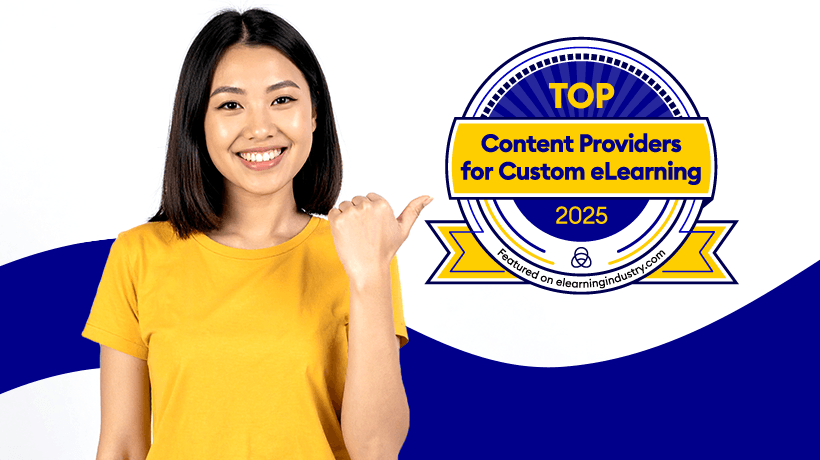Top 47 Tips eLearning Experts Share For Successful Custom eLearning Content Development
After contacting some of the finest eLearning professionals in the industry and putting out the question of what practices actually make custom eLearning content successful, I present to you with some of the top tips they had to offer.

eBook Release
Get a Free PDF Download for a Successful Custom eLearning Content Development!
The Best Custom eLearning Content Development Experts share their personal stories and anecdotes.
- Bonding with your SMEs is vital, says Abbie Martin (Global ELearning Corporation). Previously offered courses ensure higher success along with SMEs with an additional online facilitator role.
- We absolutely need to be able to understand the scope of the eLearning project, gaining an accurate idea of client expectations, by setting requirements and deadlines, states Adrian Phoon (GRC Solutions Pty Ltd).
- Amit Garg (Upside Learning Solutions) makes an interesting distinction as far as eLearning interactivity goes. He highlights the need to integrate "interactivity of the head and NOT of the hand" into our eLearning experiences. The use of the mouse does not equal active engagement, whereas the use of brain teasers getting online learner to think in a particular direction does.
- What do you want to achieve? Anne Seller (Life Science Interactive) states that this is a question that eLearning experts should take into consideration throughout the design of their eLearning course.
- Asha Pandey (EI Design) utilizes her 15-year experience to produce high quality eLearning solutions. According to her, the development methodology of your eLearning project should be based on team spirit and a flexible approach. A wide array of eLearning authoring tools must be put into play to fulfill the requirements.
- Being social makes your content development more successful, according to Aya Port (Catalyst ELearning Design). Discussion forums and group activities establish online community bonds and help learners transfer the principles of social media communication and collboration to their online training program.
- "Building assessments to measure the achievement of Learning Objectives" is clearly stressed by Ayesha Habeeb Omer (CommLab India) who makes use of Bloom's theory in crafting the ideal online learner assessment strategy.
- You have to be really sure about the reasons that made you choose custom eLearning content in the first place. Bhanwar Singh (DelphianLogic Technologies) believes we should opt for custom by choice, not by chance. Custom content is mostly related to project-specific instructional designs that also influence pricing, quality and timelines, according to him.
- Bronya Benvin (PulseLearning), with 10 years of experience in developing groundbreaking multifaceted eLearning courses, advocates the need to follow a watertight process. She highlights the immense importance of a bulletproof procedure that enables the organization to adequately organize the time and budget allocated to the eLearning project.
- An eLearning course should not be just a series of randomly connected modules but an eLearning course that creates a logical flow of eLearning content which online learners can easily follow, states Carin Neethling (Yokufunda Consulting Pty Ltd).
- Carole Bower (Lumesse) very eloquently advises to know how to save time effectively, and resist the urge to take shortcuts due to time limitations that, more often than not, undermine the quality of the end result.
- Sometimes online learners find it hard to determine the value of an eLearning course, not to mention see how they could apply it in real-life circumstances. According to Chip Cleary (City & Guilds Kineo) eLearning courses that help learners take action is what every eLearning professional should strive for.
- Christopher Part (Instructional Designer) stresses the need to develop measurable learning objectives and encourages us to always evaluate our tasks and if they align with enhanncement of employee performance.
- Daniel Gimness (DGS Designs) suggests we avoid making any last minute changes on our storyboard as this might lead to delays in deployment and might also undermine the quality of the end result.
- Danielle Wallace (Beyond The Sky: Custom Learning) highlights the significance of effective Project Management in the development of custom eLearning experiences by means of a well-put comparison: She compares custom eLearning content to a table, with the table's surface being effective Project Management, thus indicating up front the importance of it in the design of efficient eLearning courses.
- Communicating Project Goals is of upmost importance for the success of a custom eLearning project accoding to Doral Andersson (E-Concepts. Inc.).
- There is a tendency to focus too much on eLearning content nowadays, neglecting the importance of focusing on performance outcomes achieved by online learners, says Ethan Edwards (Allen Interactions). eLearning courses should first provide context, challenge, activity and feedback, and channel all these into fulfilling performance requirements.
- Storyboarding is crucial in the development of any eLearning course. Freddie Batista (Great HealthWorks) highlights the importance of an interactive and creative storyboard that presents objectives in a crystal clear way and is reviewed for grammatical accuracy.
- Accoding to Hannah Wysome (Kineo) the overall user experience has a huge bearing on the effectiveness of eLearning.
- Client solutions consultant Jane Lunt (Walkgrove) stresses the significance of understanding the subject matter. Extensive subject research, with the combined use of Subject Matter Experts, ensure seamless content assimilation by online learners.
- Using a scenario online learners can relate to and be challenged with is central in the successful development of a new Learning Management System for online training, suggests Janice Brown (Larmer Brown Consulting).
- "Too many cooks in the kitchen" is a common case of many Subject Matters Experts working in the same project, says Jared Garrett (Amazon). Jared suggests tasking a final SME reviewer that will decide on the final content to be included.
- While on the subject of WOWing online learners, Joe McCahill, M.Ed. (Caveo Learning) turns our focus to the importance of cherry-picking your pics. Issues such as the mood of the picture, the need to crop or resize the photo and video integration to make content more lively are central to the development of successful custom eLearning content.
- The issue of saving time is complemented by companies' attempt to reduce development costs, suggests Kevin Brake (Workplace Safety And Insurance Board). Kevin argues that today's eLearning professionals need to focus more on the ability to modify pre-made tools rather than develop new ones from scratch, as that's where the eLearning market is headed.
- Kim Gillham (Visumation) raises the issue of how important it is to involve the audience in the conversation. Not only do users feel more engaged this way, but you also trigger their background knowledge which helps them connect to the content more easily.
- According to Larry Wade (Amatrol. Inc), the "WOW Factor" plays a decisive role in keeping online learners engaged. Successful eLearning courses take advantage of new technological advances, including dazzling graphics and animations, to achieve maximum eLearning efficiency.
- Lauren Granahan (SweetRush Inc.) contributes that we should "hold at least an hour" between eLearning content development group sessions, thus allowing ourselves to come back with a fresh perspective on how to utilize all the ideas mentioned.
- In any corporate training program feedback is essential; Maja Katinić (EWyse) purposefully urges us to get eLearning feedback from as many third parties as possible to ensure that the eLearning content is aligned with the needs and requirements of our clients.
- Prototyping gives clients an indicative idea of how learning objectives can be fulfilled while adhering to time, budget and technology equipment limitations. Margaret Dempsey (EdPlus At Arizona State University) thus encourages us to leverage the power of prototyping.
- Flexible content mobile learning is quite the trend nowadays. Marie S. Lewandowski M.Ed. (Portland State Univeristy: The Office Of Academic Innovation) mentions the need to create flexible and concise responsive content that can be modified for mobile learning purposes.
- Marina Arshavskiy (Your ELearning World) agrees in that "matching assessments to learning objectives" is essential. Utilizing appropriate assessment strategies that align with the online training program's goals can go a long way in developing successful custom eLearning content.
- Martin Brown (Learning Makers Pty Ltd) applies Einstein's theory and states that we should make everything as simple as it can be, but not simpler. Martin turns our focus to the significance of simple designs and real user feedback.
- The award-winning Instructional Design expert Matthew Mason (Superb Learning) emphasizes the need to be user-focused via proper design features that apply to different online learner skills and knowledge levels.
- Michael Grube (Cognosante) urges us to pilot early and often. This way we make sure the eLearning course is always aligned with the online learners' needs and we avoid having to do last-minute changes because of user dissatisfaction with the content.
- Nicholas Avino (Origami Rocket®) argues that we should prevent open-ended editing. All projects have to adhere to strict production and launch timelines. Introducing clear feedback instructions as to the how and when is essential in staying within those timelines.
- Patti Quinn (Michaels & Associates) highlights the need to provide training support. Patti insists on the importance of proactivity in the formation of a support team to deal with any issues learners might have.
- According to Priyanka Saxena Malhotra (Exult Corporation) making the content learner-centric rather than content-centric is the differentiating factor for suceessful custom eLearning content development.
- Rahul Agrawal (G-Cube Solutions) strongly advises to ease online learners into the idea being taught each time by careful planning of the eLearning activities. Chunking the text tackles the problem of information overload that hinders effective learning and discourages online learners. Small pinpoint sentences are ideal in this context and are one of the main characteristics of successful eLearning courses.
- Shuchi Arora (Zeus Learning) stresses the importance of the "Priority Triangle" in custom eLearning content development, that consists of timeline, level of Learning, and the client's budget.
- Let's not forget to Have Fun! Stephen Victor (Obsidian Learning) is a firm believer of the view that successful custom eLearning content is the product of a collaborative effort of people who are actively and, most importantly, enjoyably contributing to the delivery of the eLearning course.
- Susan Wines (Learning Solutions Business Of Thomson Reuters (Tax & Accounting) Inc.) regards building a long-term relationship with custom clients as key, and urges us to motivate every team member towards providing quality customer care.
- Respect the adult learner. Adult learners have to be convinced that what they will learn has real-world application and is going to make their work routine better, says Tanya Hauth (Hauth Consulting).
- Teressa Potter (Teressa Potter Consulting LLC) urges us not to skip the design documents. High-level design documents and an Agile Project Management approach can help you test out your designs first and then move on with implementation to the entire project.
- Terri LoGiudice (Alliance Data Card Services) agrees in that the needs of the online learners are one of the factors that define the strategy to be employed and content to be developed.
- Tina Griffin (Kineo Pacific) proposes to start with the outcome and work back to the activity for best possible results.
- Victoria Schmidt (CyberTrain, Inc.) suggests that we establish what the pain points are. In other words, communicate with the client to understand the reasons for choosing custom content that even they themselves have not realized. Discovering those reasons, underlying or straightforward, is important in customizing the content to their needs.
- Vince Flango (General Dynamics) insists on the importance of allowing SMEs to give you content, but NOT build the course. He believes that SMEs should not have too much say in how the content will be laid out or presented as far as the instructional design goes.
So, that was a short overview of what some of the top minds of the industry had to say on what you have to do to develop stellar custom eLearning content. Check out our eBook library to learn more about custom eLearning design from top experts.
Originally published on June 26, 2017








